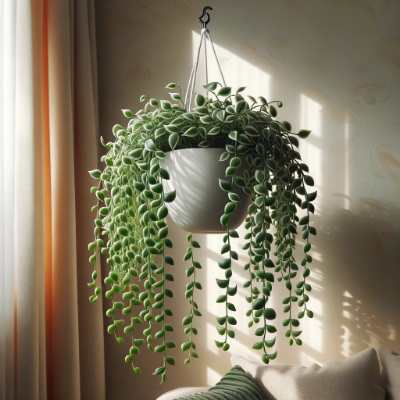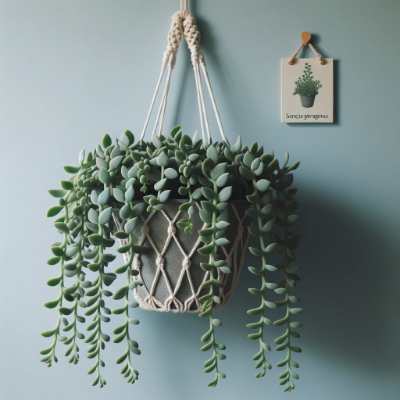String of Dolphins and String of Bananas are particular and charming succulent vegetation which have won recognition among plant lovers. Both of these vegetation belong to the Senecio genus and proportion some similarities, but they also show off special characteristics that set them aside. In this comprehensive manual, we will explore those captivating plant life in detail, inspecting their look, increase conduct, care requirements, and propagation strategies. By the give up of this text, you may have a clear know-how of the variations between String of Dolphins and String of Bananas, supporting you pick out the proper addition in your indoor or out of doors garden.
What are String of Dolphins and String of Bananas?
String of Dolphins (Senecio peregrinus) and String of Bananas (Senecio radicans) are succulent plants recognised for his or her trailing or cascading increase behavior. They are prized for his or her unusual leaf shapes and are famous picks for striking baskets and as trailing accents in gardens.
How are They Similar?
Both String of Dolphins and String of Bananas belong to the Senecio genus, which accommodates a extensive style of succulent species. As a result, they share some common traits:
Succulent Nature
Both plant life shop water in their leaves, making them drought-tolerant and ideal for arid conditions.
Trailing Growth
These succulents have a trailing or cascading growth dependancy, making them ideal for hanging pots or spilling over containers.
Low Maintenance
String of Dolphins and String of Bananas are incredibly low-upkeep flora, making them suitable for each beginner and experienced gardeners.
How are They Different?
While they proportion several similarities, there are key differences that set String of Dolphins and String of Bananas apart:
Appearance
Shape of Leaves
- String of Dolphins: The leaves of String of Dolphins resemble tiny jumping dolphins, with curved and notched edges, growing a whimsical look.
- String of Bananas: In assessment, String of Bananas has banana-fashioned leaves, hence its call. These leaves are smooth and slightly curved, corresponding to miniature bananas.
Color of Leaves
- String of Dolphins: The leaves of String of Dolphins usually show sunglasses of green, frequently with variegations or marbling in silver or cream.
- String of Bananas: String of Bananas plants typically have solid green leaves, although a few sorts may show off subtle variegation.
Size of Plant
- String of Dolphins: This plant tends to be barely smaller, with individual dolphins accomplishing lengths of around 2-three inches (5-8 cm).
- String of Bananas: String of Bananas can develop longer, with leaves accomplishing up to six inches (15 cm) in period.
Growth Habit
Trailing or Upright
- String of Dolphins: String of Dolphins generally has a trailing growth dependancy, and its stems can cascade gracefully over the sides of pots or packing containers.
- String of Bananas: While it also has a trailing dependancy, String of Bananas may additionally show off a greater upright boom sample in comparison to String of Dolphins.
Fast-developing or Slow-developing
- String of Dolphins: String of Dolphins is typically considered a slower grower compared to String of Bananas, making it a notable desire for people who select a extra manageable plant.
- String of Bananas: String of Bananas is thought for its fast growth below the right conditions, fast filling out placing baskets or trailing over garden edges.
| Feature | String of Dolphins | String of Bananas |
|---|---|---|
| Scientific name | Senecio peregrinus | Senecio radicans |
| Growth habit | Trailing succulent | Trailing succulent |
| Leaves | Long, slender, and dolphin-shaped | Plump, oval-shaped, and banana-like |
| Flowers | Small, white, and star-shaped | Small, white, and bell-shaped |
| Light requirements | Bright, indirect light | Bright, indirect light |
| Water requirements | Moderate watering | Moderate watering |
| Toxicity | Non-toxic to pets and humans | Non-toxic to pets and humans |

Care Requirements
String of Dolphins and String of Bananas have comparable care requirements, however there are subtle variations to recall.
Light
Both plant life thrive in shiny, indirect mild. They can tolerate some direct daylight, in particular in the morning or past due afternoon, however an excessive amount of direct sun can scorch their leaves. However, String of Dolphins may be barely extra touchy to severe sunlight, so it’s essential to offer some shade all through the most up to date a part of the day.
Water
These succulents favor to dry out slightly between waterings. Water very well, permitting excess water to drain from the pot. Be cautious now not to let them sit in standing water, as this may lead to root rot. String of Bananas may also require barely greater frequent watering because of its faster boom rate.
Soil
Use a nicely-draining succulent or cactus mix for each String of Dolphins and String of Bananas. Good drainage is essential to prevent root rot. You can also amend the soil with perlite or coarse sand to enhance drainage.
Fertilizer
Fertilize sparingly throughout the growing season (spring and summer time) with a balanced, diluted succulent fertilizer. Reduce or eliminate fertilization at some point of the dormant winter months. String of Bananas may additionally gain from greater common feeding due to its quicker growth.
Propagation
How to Propagate from Stem Cuttings
Propagating both String of Dolphins and String of Bananas from stem cuttings is a straightforward system:
- Select a healthy stem with several leaves.
- Use smooth, sharp scissors or pruning shears to cut a segment of the stem, making sure it’s as a minimum 2-four inches (five-10 cm) lengthy.
- Allow the reduce give up to callus over for a day or to prevent rotting.
- Plant the reducing in a properly-draining succulent mix, burying the reduce end approximately an inch (2.Five cm) into the soil.
- Keep the soil continually wet however no longer soggy till roots form, typically within some weeks to multiple months.
- Once the cutting has established roots and new growth, you can transplant it into its permanent pot or vicinity.
How to Propagate from Leaves
Both flora also can be propagated from character leaves:
- Gently pluck a healthful leaf from the figure plant, making sure you get the whole leaf, along with its base.
- Allow the leaf to air dry for a day or to let the reduce cease callus.
- Place the leaf, reduce end down, on top of nicely-draining soil or succulent blend.
- Mist the soil lightly and keep it continually moist, no longer wet.
- New plantlets will subsequently sprout from the bottom of the leaf. This manner can take numerous weeks to a few months.
- Once the new plantlets are huge enough to handle, transplant them into their personal pots.
Conclusion
In precis, even as String of Dolphins and String of Bananas share a few common traits, which include their succulent nature and trailing increase habits, they showcase distinct variations in leaf form, coloration, length, growth fee, and care requirements. Understanding these disparities is essential while identifying which plant is proper for your area and possibilities.

Summary of the Key Differences among String of Dolphins and String of Bananas
- Leaf Shape: String of Dolphins has dolphin-shaped leaves, even as String of Bananas has banana-shaped leaves.
- Leaf Color: String of Dolphins often displays variegated leaves, while String of Bananas usually has solid inexperienced leaves.
- Size: String of Dolphins is usually smaller in length compared to String of Bananas.
- Growth Rate: String of Dolphins is a slower grower, while String of Bananas can develop swiftly.
Which Plant is Right for You?
Your desire among String of Dolphins and String of Bananas will rely on your aesthetic possibilities, to be had area, and how much time you can dedicate to their care. If you’re seeking out a unique and slower-growing succulent with whimsical leaf shapes, String of Dolphins may be your chosen desire. On the other hand, in case you need a fast-developing trailing succulent with a more conventional look, String of Bananas could be the plant for you.
Troubleshooting Common Problems
String of Dolphins
- Overwatering: Yellowing or gentle leaves can imply overwatering. Allow the soil to dry out between waterings.
- Sunburn: Too much direct daylight can bring about sunburn, causing brown or white patches at the leaves. Provide partial color during the hottest part of the day.
String of Bananas
- Root Rot: Overwatering can result in root rot, which manifests as darkish, comfortable roots. Adjust your watering frequency to prevent this issue.
- Leggy Growth: If your String of Bananas becomes leggy and stretched, it may not be receiving enough mild. Move it to a brighter location.
Pests and Diseases
Both String of Dolphins and String of Bananas are usually resistant to pests and sicknesses. However, they could nevertheless stumble upon some not unusual problems:
- Mealybugs: These tiny white bugs can infest the plants, generally in the leaf axils or at the stems. Use neem oil or a aggregate of dish soap and water to deal with infestations.
- Aphids: Aphids also can be a problem, however they may be effortlessly removed by spraying with a robust move of water.
Tips for Growing Healthy Plants
- Pruning: Regularly trim leggy or unhealthy increase to encourage bushier, healthier vegetation.
- Repotting: Repot your flowers each 2-three years to refresh the soil and provide greater area for boom.
- Support: Use stakes or trellises to aid the trailing increase and prevent it from becoming tangled or broken.
In end, both String of Dolphins and String of Bananas are pleasant additions to any succulent collection. Understanding their unique traits and care requirements will help you efficiently domesticate these captivating flowers and enjoy their beauty for years yet to come.
